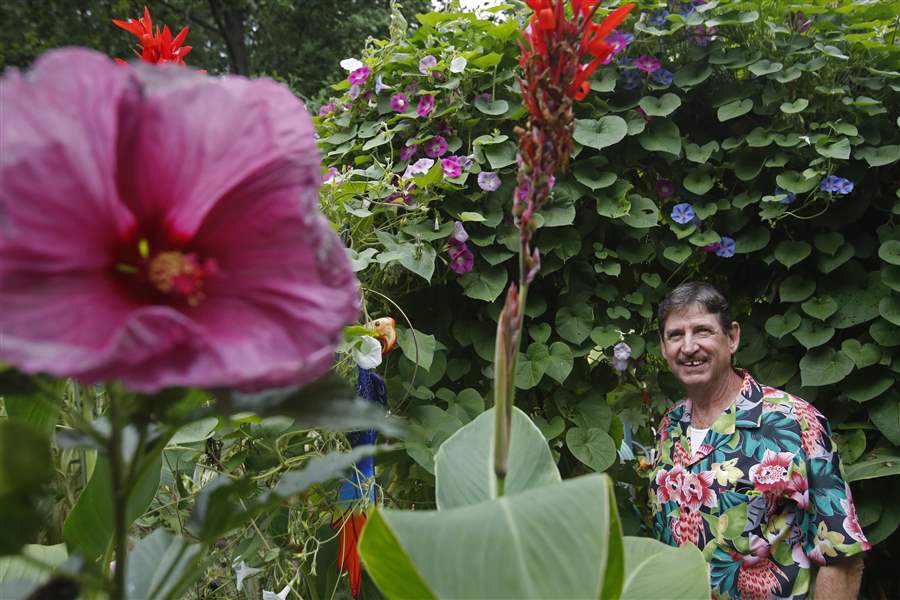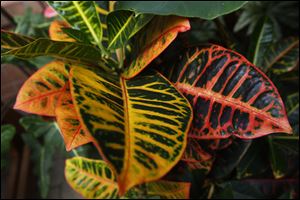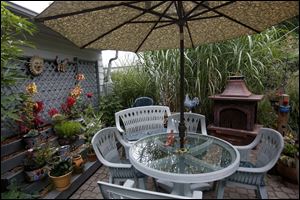
WEED IT AND REAP
Bill Albert: Garden is a testimony to organ donor
Garden is a testimony to organ donor.
9/18/2013
Bill Albert has cultivated an exotic oasis in the backyard of his Waterville home. Left, hibiscus; center, canna. Right: That's Bill!
The Blade/Katie Rausch
Buy This Image

Bill Albert has cultivated an exotic oasis in the backyard of his Waterville home. Left, hibiscus; center, canna. Right: That's Bill!
Name: Bill Albert, retired assistant state auditor, living in Waterville.
Garden specs: Front yard is 61-by-40-feet; back yard is 61-by-80-feet.
When did you start gardening? When I moved here 32 years ago. The way the garden is now began about 10 years ago. I built a 14-by-10-foot patio against the house and made a double-decker patio. It gets full sun and I wanted a southwestern effect so I planted sedums, succulents, corn grass, prickly pear, and cacti in beautiful talavera pots from Mexico. In the grassy area beyond the patio it became tropical. Still to come are a hummingbird/butterfly garden and a shade garden.
PHOTO GALLERY: Bill's Garden
What do you grow? Alocasia, anthurium, amaranthus Joseph’s coat (tricolored), 14-foot-tall banana trees, bromeliad caladium, cactus, canna, castor bean, coleus, colocasia (elephant ear), hibiscus, tibouchina, ornamental grasses: erianthus ravennae (ravenna grass), miscanthus sinensis strictus (porcupine grass), and arundo donax (giant cane). The long, thin stalks of erianthus ravennae stalks can be cut and used similar to bamboo.

His patio includes Mexican tiles and growing containers, called Talavera Pots, stacked on tiers.
Favorite plant: Tiger eye sumac. Its looks say ‘tropical” and the foliage changes color from month to month. The tropical ambiance depends on all the plants I’ve selected. The very tall bananas and castor bean provide shard for the coleus and caladium in this sunny garden. The hibiscus provide punch as do the canna.
Give us a tip: Save those autumn leaves. Several neighbors give them to me and I pile them on all the beds, three to four-feet thick. All it takes is a damp night in October and they won’t blow away, they’ll mat. They’re more natural and far less expensive than any wood chips, pine needles, or bark chips. On Mother’s Day, I uncover everything, pulling the leaves off and shredding them twice with a five-horsepower shredder; it becomes my mulch and compost and I have minimal weeds. Putting leaves on the banana trees is essential. I chop them down to the ground before covering them with leaves, the idea is not to let water get to the roots and freeze them. The banana trees have multiplied from the few I originally purchased. I’ve tried the same technique with cannas but I find only dead canna clumps in the spring. I bring inside a lot of pots and plants to overwinter: cannas, caladium, elephant ears, cacti, moses-in-a-basket, bird of paradise, Madagascar palm.
Another tip: purchase a cheap pair of chromadepth 3-D glasses. You’ll never look at your garden the same way again. All the colors pop out.
Hours spent gardening: After I’ve uncovered the beds, shredded the leaves, and put in the plants, I might do 4 to 6 hours a week. I purposely give myself many tasks to do, just because.
Annual expense: $100-$200. I start a lot from seed. Many plants are under grow lights for a few months before they’re brought outside in the spring. Corms, tubers, rhizomes, and bulbs, are dug up and boxed each fall.

This tropical plant is a croton.
Challenges: Creating a tropical garden in a zone 6 environment with relatively moderate effort. Also, I get melancholy each autumn. It is a very dramatic change come the first hard frost.
I’m proud of: Doing this at all, because for many years I lived with declining health due to primary biliary cirrhosis, an auto-immune deficiency disease that was not diagnosed until I was in my 40s. I had to repeat my freshman year of high school because my illness was not diagnosed. I drank hydrochloric acid before every meal — they tried to treat me for too much acid, but it turned out I didn’t have enough and my stomach was being shredded. I was on oxygen 24/7 and could maybe do 10 minutes of gardening before having to rest. I had taken an artistic welding class at Owens Community College where I’d built a torii [a traditional Japanese gate often found at shrines] but couldn’t finish it so it was in the garage rusting. In 2010, I received a liver transplant and after that I was doing things I hadn’t done for decades such as biking 10 to 20 miles regularly. I finished the torii and dedicated it to my blessed liver donor. The garden is a living testimony to the gift of life I received from that person.

He began by building a patio and filling it with cacti and other plants from the southewst. These beautiful tiles and containers are Talavera pottery. A restored firepit, right.
What I’ve gotten out of gardening: I’ve become a great fan of Jimmy Buffet, steel drum bands, and mangoritas. I’ve built a free-standing screened-in room out back and lined the walls with bamboo.
Contact Tahree Lane at tlane@theblade.com and 419-724-6075.